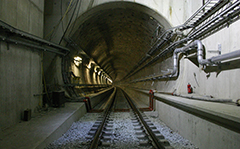Tunnels Construction
The Channel Tunnel is a 50.45-kilometre (31.35 mi) rail tunnel linking Folkestone, Kent, in the United Kingdom, with Coquelles, Pas-de-Calais, near Calais in northern France, beneath the English Channel at the Strait of Dover. At its lowest point, it is 75 m (250 ft) deep below the sea bed and 115 m (380 ft) below sea level. At 37.9 kilometres (23.5 mi), the tunnel has the longest undersea portion of any tunnel in the world, although the Seikan Tunnel in Japan is both longer overall at 53.85 kilometres (33.46 mi) and deeper at 240 metres (790 ft) below sea level. The speed limit for trains in the tunnel is 160 kilometres per hour (99 mph).
The tunnel carries high-speed Eurostar passenger trains, the Eurotunnel Shuttle for road vehicles—the largest such transport in the world and international goods trains. The tunnel connects end-to-end with the LGV Nord and High Speed 1 high-speed railway lines.
The tunnel carries high-speed Eurostar passenger trains, the Eurotunnel Shuttle for road vehicles—the largest such transport in the world and international goods trains. The tunnel connects end-to-end with the LGV Nord and High Speed 1 high-speed railway lines.
Ideas for a cross-Channel fixed link appeared as early as 1802, but British political and press pressure over the compromising of national security stalled attempts to construct a tunnel. An early attempt at building a Channel Tunnel was made in the late 19th century, on the English side "in the hope of forcing the hand of the English Government". The eventual successful project, organised by Eurotunnel, began construction in 1988 and opened in 1994. At £5.5 billion (1985 prices), it was at the time the most expensive construction project ever proposed. The cost finally amounted to £9 billion ($21 billion), well over its predicted budget.
Since its construction, the tunnel has faced a few mechanical problems. Both fires and cold weather have temporarily disrupted its operation.
People have attempted to use the tunnel to enter the UK illegally since 1997, creating the ongoing issue of the migrants around Calais on the French side, causing both diplomatic disagreement, as well as violence. More details
Since its construction, the tunnel has faced a few mechanical problems. Both fires and cold weather have temporarily disrupted its operation.
People have attempted to use the tunnel to enter the UK illegally since 1997, creating the ongoing issue of the migrants around Calais on the French side, causing both diplomatic disagreement, as well as violence. More details

